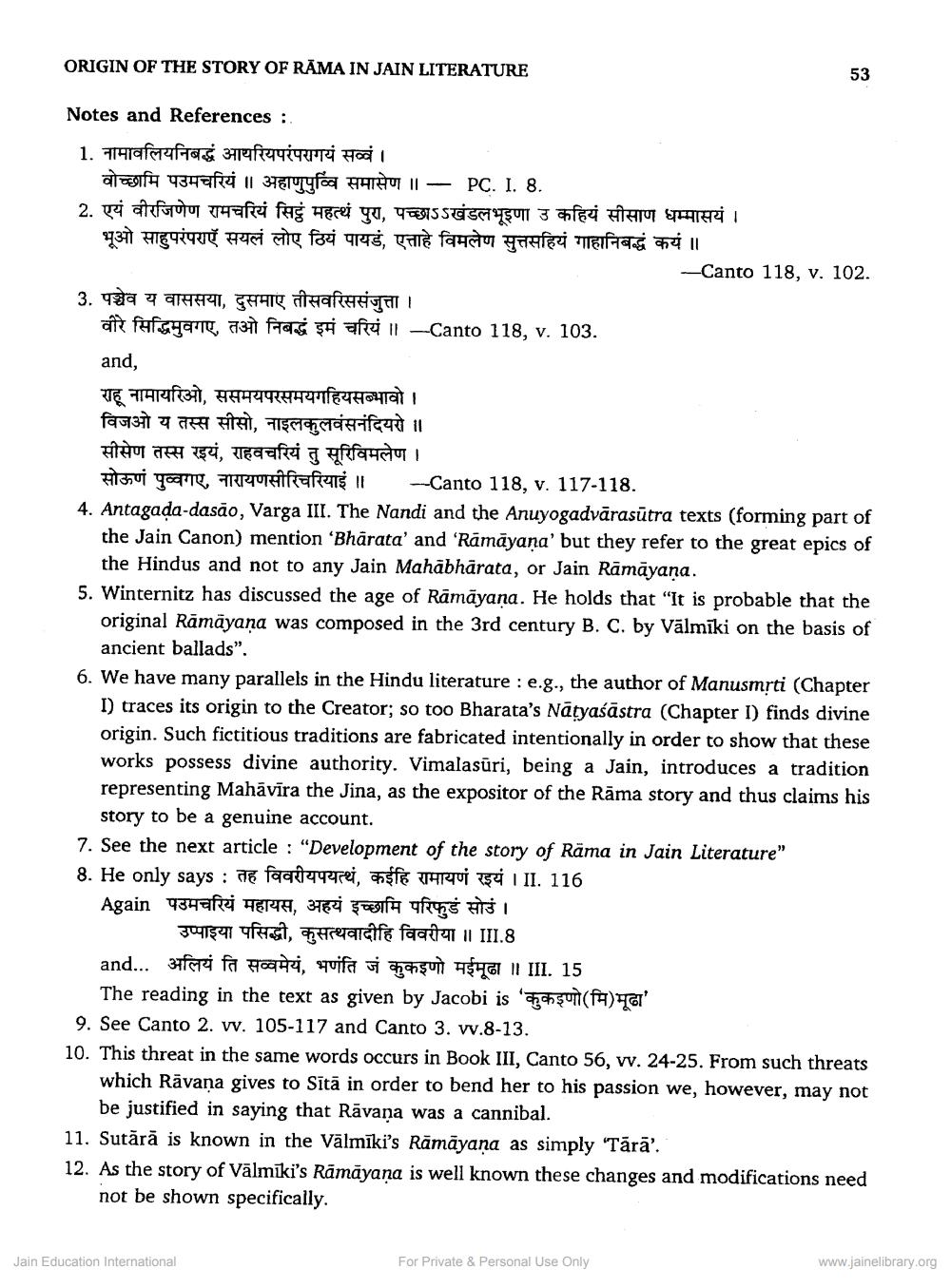________________
ORIGIN OF THE STORY OF RĀMA IN JAIN LITERATURE
53
Notes and References : 1. नामावलियनिबद्धं आयरियपरंपरागयं सव्वं ।
वोच्छामि पउमचरियं ।। अहाणुपुव्वि समासेण || - PC. I. 8. 2. एयं वीरजिणेण रामचरियं सिटुं महत्थं पुरा, पच्छाऽऽखंडलभूइणा उ कहियं सीसाण धम्मासयं । भूओ साहुपरंपराएँ सयलं लोए ठियं पायडं, एत्ताहे विमलेण सुत्तसहियं गाहानिबद्धं कयं ।।
-Canto 118, v. 102. 3. पञ्चेव य वाससया, दुसमाए तीसवरिससंजुत्ता ।
वीरे सिद्धिमुवगए, तओ निबद्धं इमं चरियं ॥ -Canto 118, v. 103. and, राहू नामायरिओ, ससमयपरसमयगहियसब्भावो । विजओ य तस्स सीसो, नाइलकुलवंसनंदियरो । सीसेण तस्स रइयं, राहवचरियं तु सूरिविमलेण ।
सोऊणं पुव्वगए, नारायणसीरिचरियाई ।। -Canto 118, v. 117-118. 4. Antagada-dasão, Varga III. The Nandi and the Anuyogadvārasūtra texts (forming part of
the Jain Canon) mention 'Bharata' and 'Rāmāyaṇa' but they refer to the great epics of
the Hindus and not to any Jain Mahābhārata, or Jain Rāmāyana. 5. Winternitz has discussed the age of Ramayana. He holds that "It is probable that the
original Rāmāyaṇa was composed in the 3rd century B. C. by Vālmīki on the basis of
ancient ballads". 6. We have many parallels in the Hindu literature : e.g., the author of Manusmrti (Chapter
I) traces its origin to the Creator; so too Bharata's Natyaśāstra (Chapter 1) finds divine origin. Such fictitious traditions are fabricated intentionally in order to show that these works possess divine authority. Vimalasūri, being a Jain, introduces a tradition representing Mahāvīra the Jina, as the expositor of the Rāma story and thus claims his
story to be a genuine account. 7. See the next article : “Development of the story of Rama in Jain Literature" 8. He only says : तह विवरीयपयत्थं, कईहि रामायणं रइयं । II. 116 Again पउमचरियं महायस, अहयं इच्छामि परिफुडं सोउं ।
उप्पाइया पसिद्धी, कुसत्थवादीहि विवरीया || III.8 and... अलियं ति सव्वमेयं, भणंति जं ककइणो मईमढा || III. 15
The reading in the text as given by Jacobi is 'कुकइणो(मि)मूढा' 9. See Canto 2. V. 105-117 and Canto 3. vw.8-13. 10. This threat in the same words occurs in Book III, Canto 56, v. 24-25. From such threats
which Rävaņa gives to Sītā in order to bend her to his passion we, however, may not
be justified in saying that Rāvana was a cannibal. 11. Sutārā is known in the Vālmīki's Rāmāyana as simply "Tārā'. 12. As the story of Vālmīki's Rāmāyana is well known these changes and modifications need
not be shown specifically.
Jain Education International
For Private & Personal Use Only
www.jainelibrary.org




